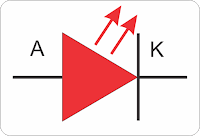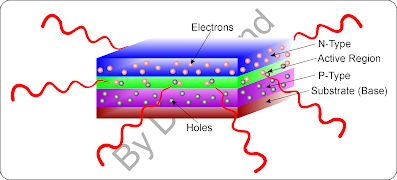 |
| LED & 7-Segment Display |
Let us now learn about Light
Emitting Diode (LED) and 7-Segment display which is combination of eight LEDs.
LED comes in many different colors now a day, like White, Red, Blue, Green and
Yellow etc. LED are very commonly seen around us as indicators on different
device to indicate power ON condition and used as decorative light around us.
The most common place where LED is used but usually not recognized by us is the
LED TV, where each pixel contains three micro LEDs with basic color i.e. Red,
Blue and Green. If we see a large sized LED screens very closely, we may be able to identify
| Pixel |
 |
| LED |
LED is a PN junction
semiconductor which emits light when current flows through it. Its symbol
indicates a PN junction diode with two small arrows indicating emission of
light. Being similar to PN junction diode it allows current to flow in only one
direction from anode to cathode when it is under forward biased condition, not
in reverse condition. Anode should be connected to positive supply and cathode
should be connected to negative supply.
The light energy is generated when
electrons combines with holes, it releases
 |
| LED Symbol |
energy in form of photons. Anode
terminal is longer in size and cathode terminal is smaller in size. The color
of light emitted depends on energy required by electrons to cross the band gap.
White color is obtained by using phosphorus layer with semiconductor layer;
similarly other colors are obtained by combination with different materials
like Indium Gallium Nitrate (InGaN), Aluminum gallium indium phosphide
(AlGaInP), Aluminum gallium arsenide (AlGaAs) and Gallium phosphide (GaP). Due
to combination of different materials different wavelength of light is
generated hence we see different colors.
 |
| LED Construction |
substrate there is a layer of ‘P’ type
material with excess of holes and on top of that we have ‘N’ type material with
excess of electrons. Under forward biased condition when holes and electrons
combine with each other in middle (mentioned as ‘Active Region’) region, it
releases light energy in form of photons.
 |
| 1 Watt LED |
Broadly we have colored LEDs in
visible light range, Infrared (IR) LEDs (used in remote controllers) and Ultra
Violet (UV) LEDs used in machines for original currency verification and other
industrial use. All these LEDs uses very low power to emit light, most of the
small LEDs need 1.8V to 3.3V and current in range of 10mA to 20mA. So, if we
calculate the power using P = V x I we get maximum power of 3.3Vx20mA = 66milli
Watt. Since last many years we have got higher power LEDs in the range of 1W,
3W, 5W, 10W, 20W, 50W etc. which are now used in LED lamps, street lights,
flood light in stadium etc. The more power they consume, comparable energy is
also released in the form of heat hence for these high power LEDs we need to
place big heat sink material mostly of aluminum to absorb the heat, else the
LED will damage. These high power LEDs are much efficient as compared to
conventional light bulbs, halogen bulbs or old mercury vapor and sodium vapor
street lamps because LED releases less heat and more light compared to other lamps.
Hence these LED lamps are now a day more popular and conventional old lamps are
getting obsolete.
Note: We
should not look directly from front of White LED and high power LEDs into it, as
huge amount of light is generated in very small area inside LED so the
intensity of light at this point is too high and looking directly into it may
hurt your eyes.
 |
| LED Circuit |
the value of resistor to be used in
circuit to control the flow of current through LED to avoid damaging the LED with
over current. We will connect the LED with two pencil cells in series to get 3V
as red LED need 1.7V hence single cell will not work as it gives 1.5V only.
Different LEDs have different voltage drop across it during forward biased
condition, as shown in table. Here anode of LED is connected to
positive supply through current limiting resistor ‘R’ and cathode is connected
directly to negative supply. Voltage across point ‘A’ and ‘B’ is 3V and we need
voltage across LED to be at 1.7V i.e. across point ‘E’ and ‘F’, so we need to
drop the remaining voltage i.e. 3-1.7 = 1.3V across
 |
| LED Voltage Drop |
resistor ‘R’. Here we need
to decide value of resistor ‘R’ to maintain current in circuit between 10mA to
20mA. To maintain 1.3V across point ‘C’ and ‘D’, considering average current
15mA (15/1000A) using Ohms law R = V/I = 1.3/15*1000 = 86.66Ohms, so we will
take nearest available value which is 82Ω. So, the current through resistor or
through circuit with 82Ω will be I = 1.3/82 = 0.0158 = 15.8mA which is within
operating range of LEDs i.e. 10-20mA. Some other types of LED are combination of different color LEDs like RGB LED, dual LED, blinking LED, color changing LED etc.
That is how we can use different
color LEDs with different resistor combination to operate them within given
voltage and current conditions. Next let us learn about 7-Segment display which
we see around us to display numbers on different devices like calculator,
weighing machine and visitor counter at malls entry etc.
7-Segment Display
 |
| 7-Segment Display |
 |
| 7-Segment Display |
These segments are denoted as
letter ‘a’ to ‘f’ and ‘dp’ for decimal point, all these LEDs are connected to eight different pins of display with two common points on top and bottom as shown here. To display different digits we can refer table.
 |
| Display Format Table |
If we see the internal
construction of these 7-segment displays we have two types of display, one is
common anode and common cathode. In common anode type, anode terminal of all
LEDs inside the display are connected together and is connected to common pin
(com). Similarly for common cathode type, the cathode terminals of all LEDs
inside display are connected together to common pin (com). Based on circuit
requirement we can choose which type to use out of two types shown here.
 |
| Display Format of Digits |
 |
| Internal Connection |
Details inside diagram shows how the LEDs inside are connected and how each
segment LED is connected to outer pin. We can see all anode or all cathodes are
connected together to ‘com’ pin in these two types and rest terminals to other
eight pins of display.
Watch out the video to see how digits are displayed on 7-Segment display. As of now you may ignore the circuit diagram as it is out of scope at this point of time.
That’s all about 7-segment display, for any doubt leave
comment below, will respond ASAP. Keep watching for next topic.








1 Comments
Clothing and accessories price comparison A very awesome blog post. We are really grateful for your blog post. You will find a lot of approaches after visiting your post.
ReplyDelete